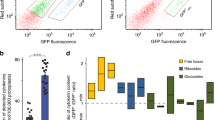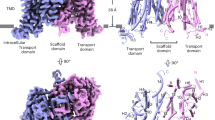Abstract
Cytokinins are a class of plant hormones that are central to the regulation of cell division and differentiation in plants1,2. It has been proposed that they are detected by a two-component system, because overexpression of the histidine kinase gene CKI1 induces typical cytokinin responses3 and genes for a set of response regulators of two-component systems can be induced by cytokinins4,5. Two-component systems use a histidine kinase as an environmental sensor and rely on a phosphorelay for signal transduction. They are common in microorganisms, and are also emerging as important signal detection routes in plants6,7,8,9. Here we report the identification of a cytokinin receptor. We identified Arabidopsis cre1 (cytokinin response 1) mutants, which exhibited reduced responses to cytokinins. The mutated gene CRE1 encodes a histidine kinase. CRE1 expression conferred a cytokinin-dependent growth phenotype on a yeast mutant that lacked the endogenous histidine kinase SLN1 (ref. 10), providing direct evidence that CRE1 is a cytokinin receptor. We also provide evidence that cytokinins can activate CRE1 to initiate phosphorelay signalling.
This is a preview of subscription content, access via your institution
Access options
Subscribe to this journal
Receive 51 print issues and online access
$199.00 per year
only $3.90 per issue
Buy this article
- Purchase on Springer Link
- Instant access to full article PDF
Prices may be subject to local taxes which are calculated during checkout




Similar content being viewed by others
References
Skoog, F. & Miller, C. O. Chemical regulation of growth and organ formation in plant tissues cultured in vitro. Symp. Soc. Exp. Biol. 11, 118–131 (1957).
Mok, M. C. in Cytokinins (eds Mok, D. W. S. & Mok, M. C.) 155–166 (CRC, Boca Raton, 1994).
Kakimoto, T. CKI1, a histidine kinase homolog implicated in cytokinin signal transduction. Science 274, 982–985 (1996).
Sakakibara, H. et al. A response-regulator homologue possibly involved in nitrogen signal transduction mediated by cytokinin in maize. Plant J. 14, 337–344 (1998).
Brandstatter, I. & Kieber, J. J. Two genes with similarity to bacterial response regulators are rapidly and specifically induced by cytokinin in Arabidopsis. Plant Cell 10, 1009–1019 (1998).
Mizuno, T. His-Asp phosphotransfer signal transduction. J. Biochem. 123, 555–563 (1998).
D'Agostino, I. B. & Kieber, J. J. Phosphorelay signal transduction: the emerging family of plant response regulators. Trends Biochem. Sci. 24, 452–456 (1999).
Chang, C., Kwok, S. F., Bleecker, A. B. & Meyerowitz, E. M. Arabidopsis ethylene-response gene ETR1: similarity of product to two-component regulators. Science 262, 539–544 (1993).
Schaller, G. E. & Bleecker, A. B. Ethylene-binding sites generated in yeast expressing the Arabidopsis ETR1 gene. Science 270, 1809–1811 (1995).
Maeda, T., Wurgler-Murphy, S. M. & Saito, H. A two-component system that regulates an osmosensing MAP kinase cascade in yeast. Nature 19, 242–245 (1994).
Cary, A. J., Liu, W. & Howell, S. H. Cytokinin action is coupled to ethylene in its effects on the inhibition of root and hypocotyl elongation in Arabidopsis thaliana seedlings. Plant Physiol. 107, 1075–1082 (1995).
Bleecker, A. B., Estelle, M. A. & Somerville, C. Insensitivity to ethylene conferred by a dominant mutation in Arabidopsis thaliana. Science 241, 1086–1089 (1988).
Lincoln, C., Britton, J. H. & Estelle, M. Growth and development of the axr1 mutants of Arabidopsis. Plant Cell 2, 1071–1080 (1990).
Koornneef, M., Reuling, G. & Karssen, C. M. The isolation and characterization of abscisic acid-insensitive mutants of Arabidopsis thaliana. Physiol. Plantar 61, 377–383 (1984).
Mähönen, A. P. et al. A novel two-component hybrid molecule regulates vascular morphogenesis of the Arabidopsis root. Genes Dev. 14, 2938–2943 (2000).
Ueguchi, C., Koizumi, H., Suzuki, T. & Mizuno, T. Novel family of sensor histidine kinase genes in Arabidopsis thaliana. Plant Cell Physiol. (in the press).
Posas, F. et al. Yeast HOG1 MAP kinase cascade is regulated by a multistep phosphorelay mechanism in the SLN1-YPD1-SSK1 “two-component” osmosensor. Cell 86, 865–875 (1996).
Schmitz, R. Y., Skoog, F., Playtis, A. J. & Leonard, N. J. Cytokinins: Synthesis and biological activity of geometric and position isomers of zeatin. Plant Physiol. 50, 702–705 (1972).
Urao, T. et al. A transmembrane hybrid-type histidine kinase in Arabidopsis functions as an osmosensor. Plant Cell 11, 1743–1754 (1999).
Miyata, S., Urao, T., Yamaguchi-Shinozaki, K. & Shinozaki, K. Characterization of genes for two-component phosphorelay mediators with a single HPt domain in Arabidopsis thaliana. FEBS Lett. 437, 11–14 (1998).
Suzuki, T., Imamura, A., Ueguchi, C. & Mizuno, T. Histidine-containing phosphotransfer (HPt) signal transducers implicated in His-to-Asp phosphorelay in Arabidopsis. Plant Cell Physiol. 39, 1258–1268 (1998).
Kubo, M. & Kakimoto, T. The CYTOKININ-HYPERSENSITIVE genes of Arabidopsis negatively regulate the cytokinin-signaling pathway for cell division and chloroplast development. Plant J. 23, 385–394 (2000).
Becker, D., Kemper, E., Schell, J. & Masterson, R. New binary vectors with selectable markers located proximal to the left T-DNA border. Plant Mol. Biol. 20, 1195–1197 (1992).
Akama, K. et al. Efficient transformation of Arabidopsis thaliana: comparison of the efficiencies with various organs, plant ecotypes and Agrobacterium strains. Plant Cell Rep. 12, 7–11 (1992).
McKinney, E. C. et al. Sequence-based identification of T-DNA insertion mutations in Arabidopsis: actin mutants act2-1 and act4-1. Plant J. 8, 613–622 (1995).
Hayashi, H., Czaja, I., Lubenow, H., Schell, J. & Walden, R. Activation of a plant gene by T-DNA tagging: auxin-independent growth in vitro. Science 258, 1350–1353 (1992).
Mumberg, D., Müller, R. & Funk, M. Yeast vectors for the controlled expression of heterologous proteins in different genetic backgrounds. Gene 156, 119–122 (1995).
Acknowledgements
M. Higuchi carried out most of the yeast work. We thank H. Saito for yeast strains, E. Kemper for pGPTV-KAN and K. Torii for comments. Seeds of abi3-1, aux1-7 and ein2-1 were obtained from ABRC. p415CYC was obtained from ATCC. This study was in part supported by grants from the Ministry of Education, Science and Culture of Japan, and from the Science and Technology Agency to T.K.
Author information
Authors and Affiliations
Corresponding author
Supplementary information
Rights and permissions
About this article
Cite this article
Inoue, T., Higuchi, M., Hashimoto, Y. et al. Identification of CRE1 as a cytokinin receptor from Arabidopsis. Nature 409, 1060–1063 (2001). https://doi.org/10.1038/35059117
Received:
Accepted:
Issue Date:
DOI: https://doi.org/10.1038/35059117
This article is cited by
-
Regulation of chloroplast biogenesis, development, and signaling by endogenous and exogenous cues
Physiology and Molecular Biology of Plants (2024)
-
Melatonin Antagonizes Cytokinin Responses to Stimulate Root Growth in Arabidopsis
Journal of Plant Growth Regulation (2023)
-
A volatile producing Bacillus subtilis strain from the rhizosphere of Haloxylon ammodendron promotes plant root development
Plant and Soil (2023)
-
Role of endogenous cytokinins and ethylene in adventitious shoot regeneration in lemon (Citrus limon)
In Vitro Cellular & Developmental Biology - Plant (2022)
-
On the biological activity of cytokinin free bases and their ribosides
Planta (2022)
Comments
By submitting a comment you agree to abide by our Terms and Community Guidelines. If you find something abusive or that does not comply with our terms or guidelines please flag it as inappropriate.



